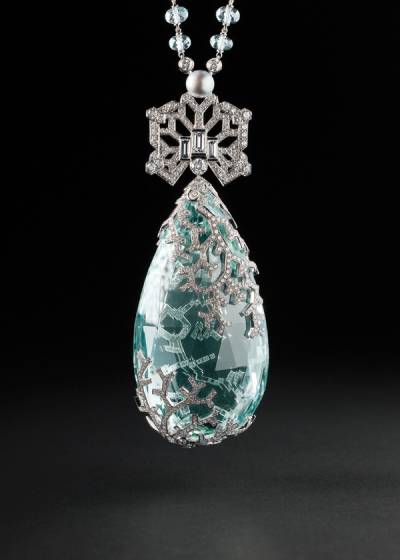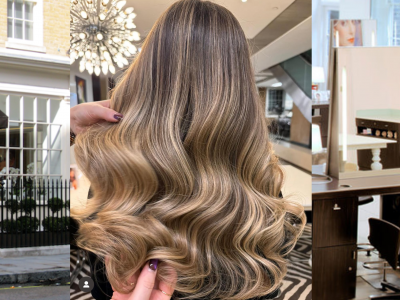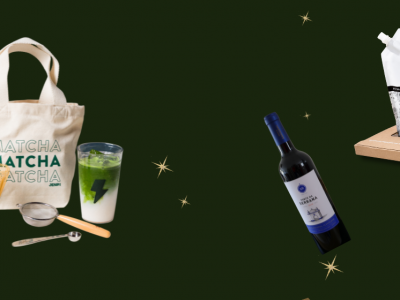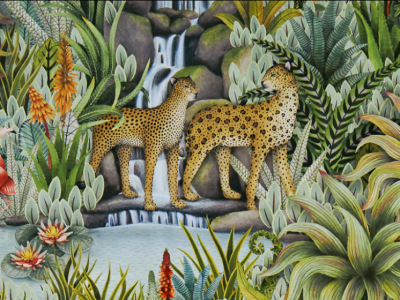Glimpses into the world of haute joaillerie are fleeting so the Biennale des Antiquaires in Paris (September 14-23) represents a rare chance to see the world’s most impressive gathering of high-worth jewels together under one roof. But it’s an opportunity only available to the elite—a lucky few ticket holders, or the specially invited top-tier clients of the most exclusive jewellery houses. The Biennale’s reputation for selling the most refined works of art and antiques means it is increasingly becoming a honeypot for jewellery lovers, too, who come to see what houses such as Bulgari, Cartier, Van Cleef & Arpels, Harry Winston and Chaumet can tempt them with. For all the Roman statues and Flemish tapestries also on display, it seems everyone is drawn to the busiest corner of the fair: the plushly carpeted jewellery section. Here you will see the stuff of dreams: heart-achingly beautiful creations by 10 of the world’s most exclusive jewellers who have worked non-stop for this occasion, when they can present the best of the best to the world’s wealthiest. Jewels worth countless millions sparkle and wink out from behind the thick glass display-cases lining an avenue of temporary boutiques under the soaring steel arches and glass domes of the Grand Palais.
Haute joaillerie: the world's most exclusive jewellery
16th March 2013
The most stunning jewellery comes together every two years as the world’s exclusive jewellery houses exhibit at the Biennale des Antiquaires at the Grand Palais in Paris. Maria Doulton discovers what’s tempting its elite visitors
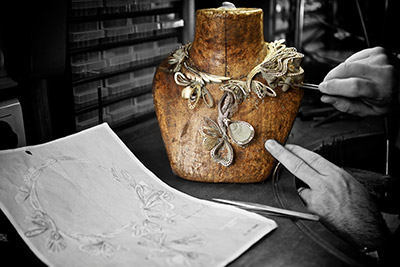
Working on Boucheron’s “Bouquet d’Ailes necklace, to be set with emeralds, sapphires and diamonds
When talking of jewels as individual as these, it is tempting to compare them to works of art. Each piece is usually a one-off and its value reflects not just the rare stones but the hundreds of hours of work in the ateliers that went into its creation. Take the “Palais de la Chance” collection from Van Cleef & Arpels. The brand is big on themes and this year the story told in gems and gold is all about luck and its many symbols and manifestations across the world and through the ages.
But forget tame four leaf clovers; Van Cleef & Arpels has really gone to town. The “Zodiac Set Libra” necklace is a navel-grazing sautoir of Asian-inspired design featuring black onyx beads, cultured pearls, zesty green tsavorite garnets and glimpses of glossy coral. The “Swallows” necklace features these winged bearers of good fortune swooping through cascades of chrysoprase beads, emeralds, tsavorites and garnets. Chaumet, meanwhile, is taking inspiration from its address with the “12 Place Vendôme” collection, where the Maison has resided since 1780.
Consisting of over 40 tiaras that combine the classic elements of the house with modern touches, the creations look fresh and young yet maintain their aristocratic air in keeping with their inspiration, none other than Empress Joséphine herself, the first muse of the house. Modern-day princesses can have an aigrette, or head jewel, with a spray of coquettish white feathers that can be worn as a tiara. In another clever touch, the central piece featuring a large opal can be detached and worn as a brooch or hung from a chain as a pendant.
Boucheron, another Place Vendôme stalwart, revisits the classic icons of the house, including the snake, the chameleon and ivy, and gives them a thoroughly modern twist, presumably for an audience that wants jewels as cutting edge as their couture wardrobes. In the “Lierre de Paris” piece, diamond-set tendrils of ivy push through a cobblestone of 200 carats of greenish-grey rough diamonds and drape around the neck to make a dramatic statement. The “Bouquet d’Ailes” necklace features dragonflies and peacock feathers in a tribute to 19th-century naturalists. Harry Winston is sure to cause ripples with its “Water” jewels that bring an unexpected splash of cool blue hues to their normally all-white diamond offerings. Drops of diamonds, swimming-pool blue Paraiba tourmalines and aquamarines are suspended in platinum wire lines on the aptly named “Waterfall” necklace, which cascades down the neck with the lightness and movement of flowing water.
Bulgari, at the Biennale for the first time, shows its flair for combinations of deep-hued, glossy coloured gemstones, the highlight of which is the emerald and diamond necklace worthy of the great emerald lover Queen Cleopatra herself. Cartier, meanwhile, has had a presence at the Biennale since 1964 and this year brings a collection of 148 pieces to the fair. But, as, Jacqueline Karachi-Langane, Cartier’s creative director, points out, however modern the pieces may look, they always reflect traditional ideas and designs from Cartier’s archives, be it combinations of colours, a particular stone cut or perhaps simply the very “Cartier” quality of the craftsmanship. The unifying theme of the jewellery is the evocation of different landscapes, ranging from the lush and sun-drenched to the urban. From cute penguins in glacial landscapes to the hot dusty colours of Africa or the cool sheen of steel and diamonds mimicking contemporary architecture, what we see is a dazzling array of settings, colours and stones in a collection that took two years to bring to life. This year, Cartier is the largest exhibitor with a 250m2 stand designed by renowned French designer Tristan Auer.
Elsewhere, the influence of couture in high jewellery is increasing year on year as the fashion houses offer ever more elaborate and valuable jewels. Chanel launches its biggest collection of diamond jewels to celebrate the 80th anniversary of Gabrielle Chanel’s Bijoux de Diamants exhibition. Dior presents its “Dear Dior” jewels inspired by the costume jewels that Christian Dior himself created for his couture shows. The result is an extravaganza of colour with outsized rings, earrings and brooches. As with all of designer Victoire de Castellane’s work, it never fails to surprise with its eye-searingly bright and unexpected combinations of stones—opals in particular. In contrast to the beautiful, jostling chaos of crumbled layers of stone, on the back of each piece are dainty renditions of lace in metal, the designs of which are all from the Dior lace archives from the 1950s.
Piaget, the Swiss house better known for its watches, presents its biggest and most ambitious collection of jewels. “Couture Précieuse” uses the limited colour palette of white diamonds, red rubellites, and mysterious black spinels to tell a tale of seduction through jewels that mimic lace, corsets, ribbons and tassels. The collection is marked by a lightness of feeling created by open-work settings and a mix of diamond cuts such as brilliants and baguettes to create a richer sparkle and a more relaxed look. Chinese-born Wallace Chan is the new boy on the block at the Biennale. Chan started work as an apprentice of traditional Chinese carving and now favours titanium and unusual stone combinations, often in layers or embedded in each other. Inspired by the frailty and power of nature, Chan’s work is technically superb and always bursting with creativity. Prices are hard to come by but a diamond ring was the lightest $10 million I have ever slipped on. But the Biennale des Antiquaires is not simply about big rocks for the super rich; it is for anyone who dares to dream. I could really see myself in those gently glowing pearl and moonstone earrings from Boucheron or Dior’s vivid green “Bouquet d’Opales” ring. But for another close encounter with such a rich feast of jewels, I will have to wait another two years.
